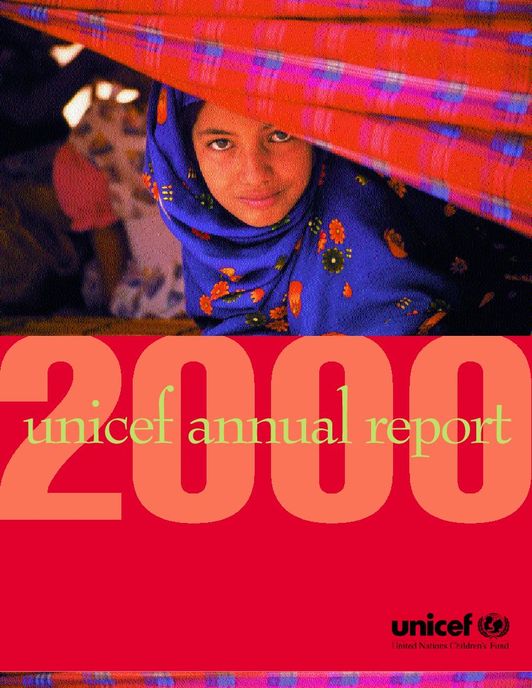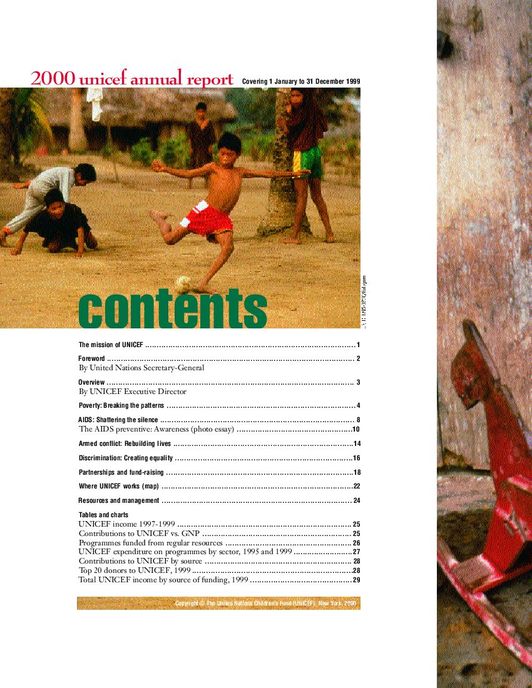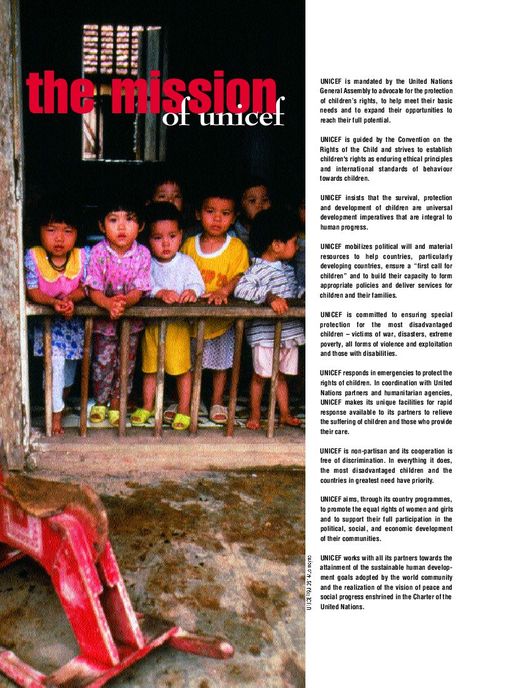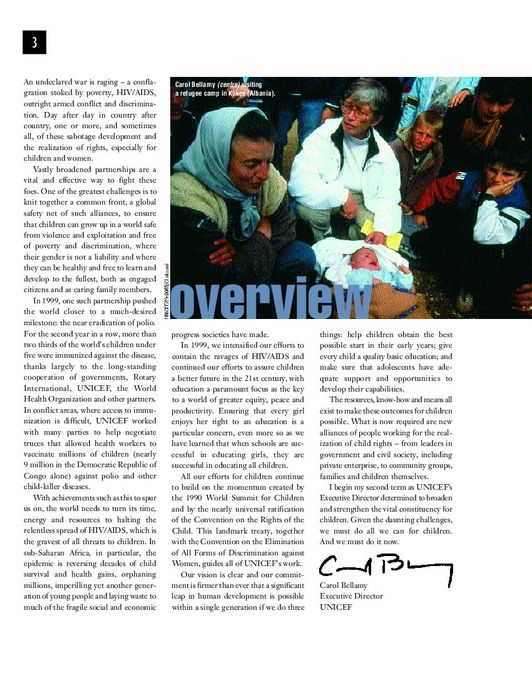Reporte Anual UNICEF 2000
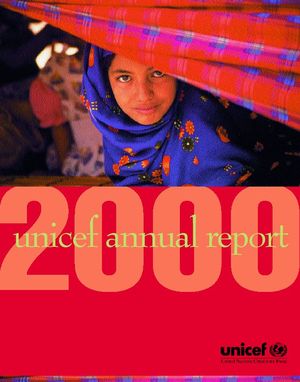
Vista previa
Se requiere el inicio de sesión
Usted debe ser miembro de la comunidad ForChildren.com para descargar recursos. ¡Haga clic en los botones de abajo para iniciar sesión o registrarse!
| Categoría | Protección del niño |
Facing theC h a l l e n g e Poverty is a fact of life for more than 1 billion people on earth – and half of them are children. Along with women, children suffer the most when resources are scarce. At least 600 million children and adolescents grow up in families struggling to survive on incomes of less than $1 a day. But no dollar measurement can convey the hardship of children who are malnourished, whose water is unsafe to drink, who miss school and who grow up without ever visiting the inside of a health facility. Poverty not only destroys hopes and opportunities but also causes lasting damage to young minds and bodies. In developing countries, poverty is the root cause of the tragic fact that around 11 million children under five die each year, mostly from preventable diseases, and malnutrition plays a major role in around half of these deaths. Pneumonia, diarrhoea, malaria and measles are the main killers. P o v e r t y ’s hand is also evident when children are not in school or receive poor-quality education, when children work at hazardous and exploitative jobs, when girls marry and become pregnant early and when families succumb to domestic violence. In poverty, girls fare the worst. They are more likely than boys to miss out on health, education and other basic social services, and their disadvantage grows in times of economic downturn. Many factors are quickening the downward spiral of poverty: the devastation brought on by HIV/AIDS, especially in sub-Saharan Africa; the re-emergence of malaria and tuberculosis as major health emergencies in many countries; and armed conflicts, which continue to decimate societies and drain their resources. Nations are grappling with all these problems at a time when development assistance has plummeted and debt burdens have reached an all-time high. Ac h i eving Results Childhood is the most crucial time for b reaking povert y ’s cycle. Our work begins during a child’s first years, when the foundations are laid for lifelong educational attainment, health and productivity. We support programmes that provide very young children with good health care, adequate nutrition, intellectual stimulation, protection from violence and opportunities to play. And we work with partners at all levels to help provide school-age children with a quality education – the most important stepping stone out of povert y. During the adolescent years, we assist in providing young people with the support and guidance they need to develop their potential and contribute their ideas and talents to the societies in which they live. UNICEF values children’s opinions about how best to accomplish these ends and encourages young people to participate in making decisions affecting their lives. In 1999, for example, in 20 countries in the Americas and the Caribbean, UNICEF polled 12,000 children aged 9 to 18 about which issues were important to them. Results of the poll will help inform our work in the region. UNICEF supports the eff o rts of nations to invest in good health care, quality education and a safe and supportive environment for children and to meet the year 2000 goals for the surv i v a l , protection and development of children, established at the 1990 World Summit for Children. One result of these efforts is that nearly three out of every four children in developing countries now have access to clean water. And a larger p e rcentage of children are now in school than at any time previously.
Documentos relacionados
-
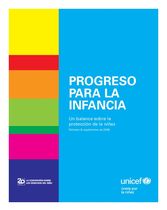
Progreso para la Infancia Un balance sobre la protección de la niñez Número 8, septiembre de 20…
En todo el mundo hay demasiados niños sometidos a la violencia, la explotación y el abuso. Algunos tienen que trabajar a la fuerza en c… -
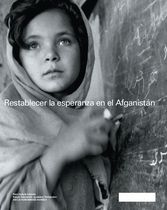
Restablecer la esperanza en el Afganistán
tado sus familias y comunidades y arruinado su sistema educativo. Dos generaciones privadas de su futuro. Aún así, el pueblo del Afgani… -
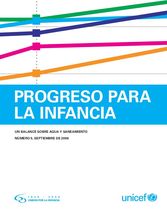
PROGRESO PARA LA INFANCIA UN BALANCE SOBRE AGUA Y SANEAMIENTO NÚMERO 5,
Se calcula que el agua no apta para el consumo y la falta de saneamiento básico y de higiene cuestan la vida todos los años de má… -
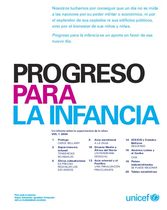
PROGRESO PARA LA INFANCIA Un informe sobre la supervivencia de la niñez Vol I
El compromiso del UNICEF con la supervivencia infantil es tan antiguo como la propia organización. En los años 1990 y 1950, el UNICEF p… -
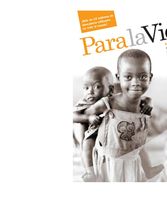
Para la Vida con consejos sobre maternidad sin riesgos lactancia materna y mucho más
Todos los años, cerca de 11 millones de niños mueren antes de cumplir los cinco años –muchos de ellos durante el primer a&… -
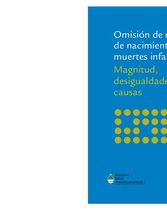
Omisión de registro de nacimientos y muertes infantiles Magnitud, desigualdades y causas
Este libro presenta un estudio multicéntrico realizado en el año 2005 y coordinado por la Dirección de Estadísticas e Inf… -

No queremos pistolas. Somos niños
Análisis de la cultura de la violencia y niñez, niños soldados entre otras temáticas afines. -

PROGRESO PARA LA INFANCIA Lograr los Objetivos de Desarrollo del Milenio con equidad
Esta es la historia de una niña nacida en uno de los lugares más pobres del mundo, probablemente en África subsahariana. Podr&ia… -
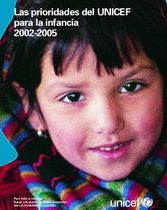
Las prioridades del UNICEF para la infancia 2002-2005
El UNICEF ha comprometido sus recursos para lograr resultados en beneficio de los niños y niñas en las cinco siguientes esferas priorit… -

La infancia y el SIDA Tercer inventario de la situación 2008
Este inventario de la situación, el tercero desde que la iniciativa Únete por la niñez, Únete con la juventud, Úne…
ForChildren.com, presentado por Compassion International, ofrece ideas, oportunidades de aprendizaje y relaciones para ayudar a equipar a las personas que trabajan con niños en situación de riesgo. Somos una comunidad mundial de seguidores de Jesús comprometidos con el desarrollo integral de los niños. Lo invitamos a que se una a nosotros como comunidad colaborativa para compartir con otros las ideas, experiencias, métodos y herramientas que ayuden a los niños a triunfar incluso en la peor de las adversidades.
ForChildren.com es presentado por Compassion International, una organización 501(c)3 registrada sin fines de lucro. Todos los recursos, los cursos y las discusiones son para propósitos educativos únicamente, no para lucrar.





